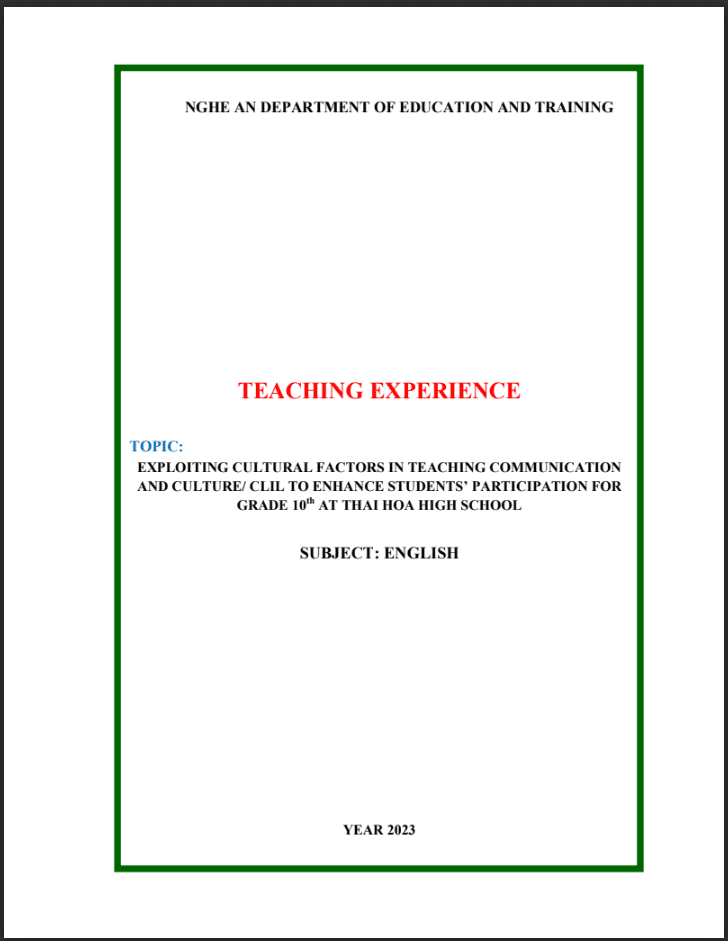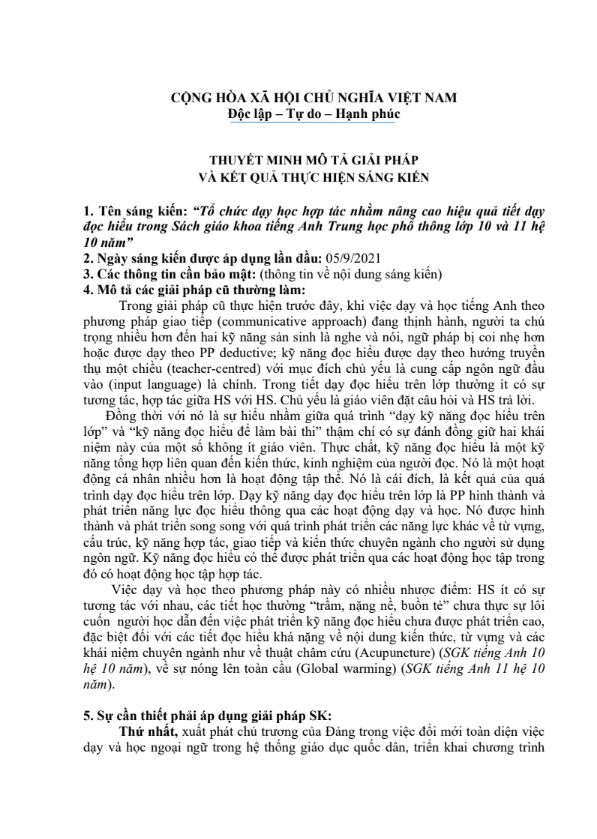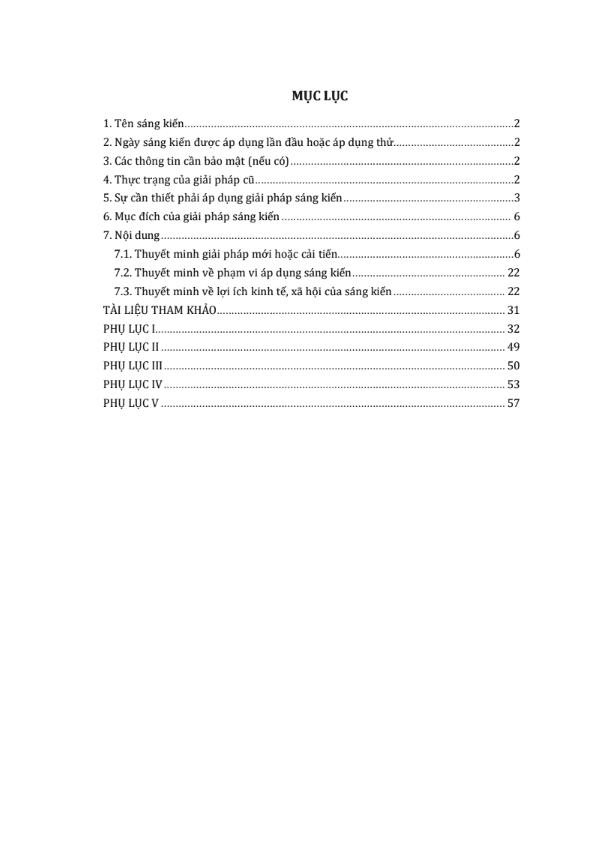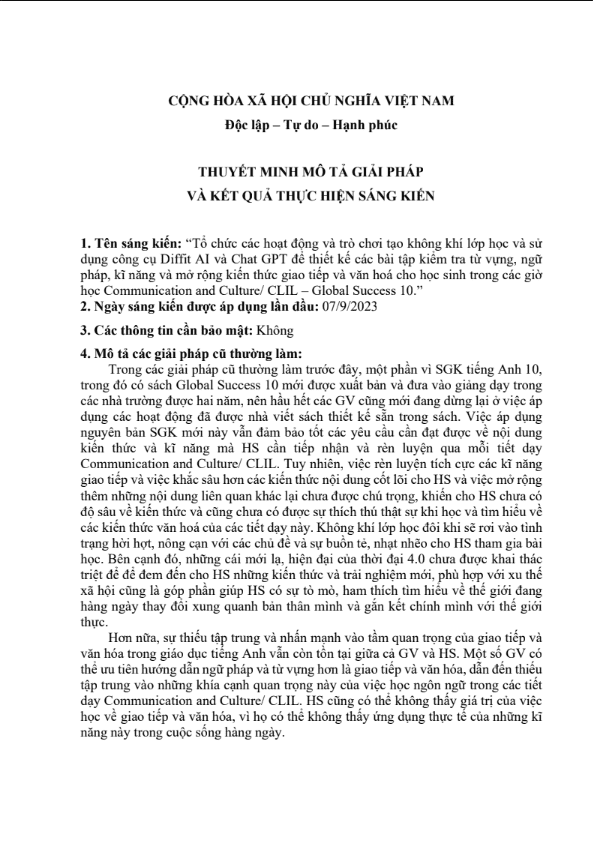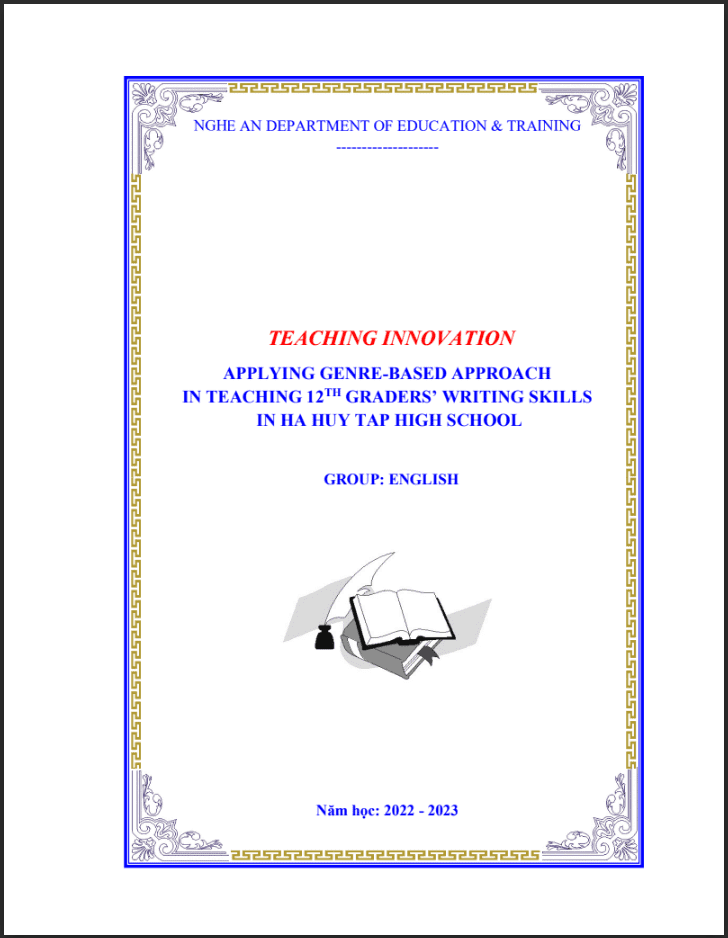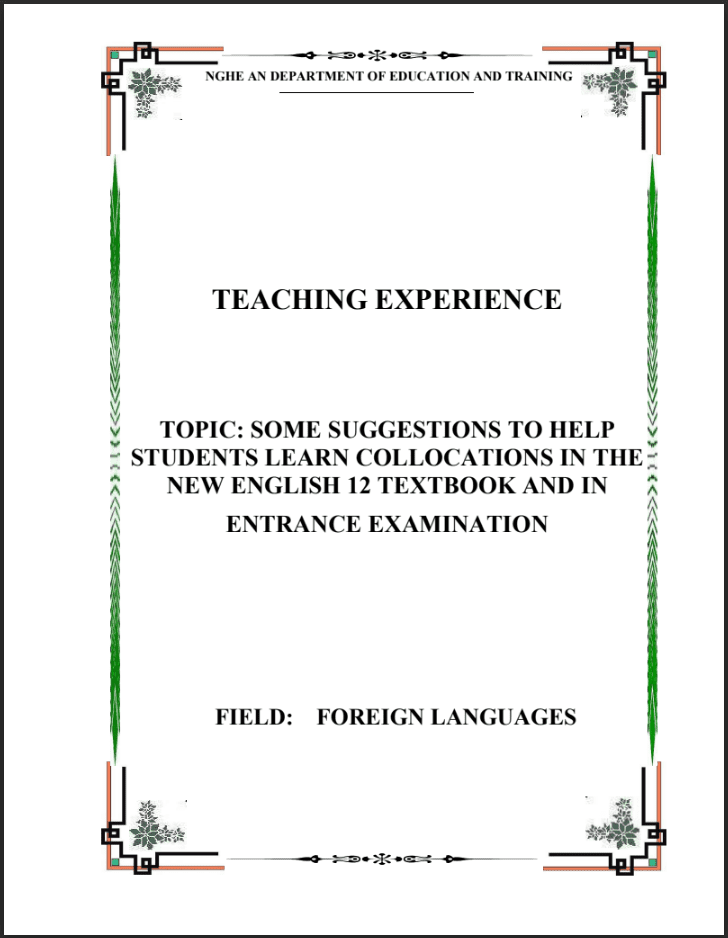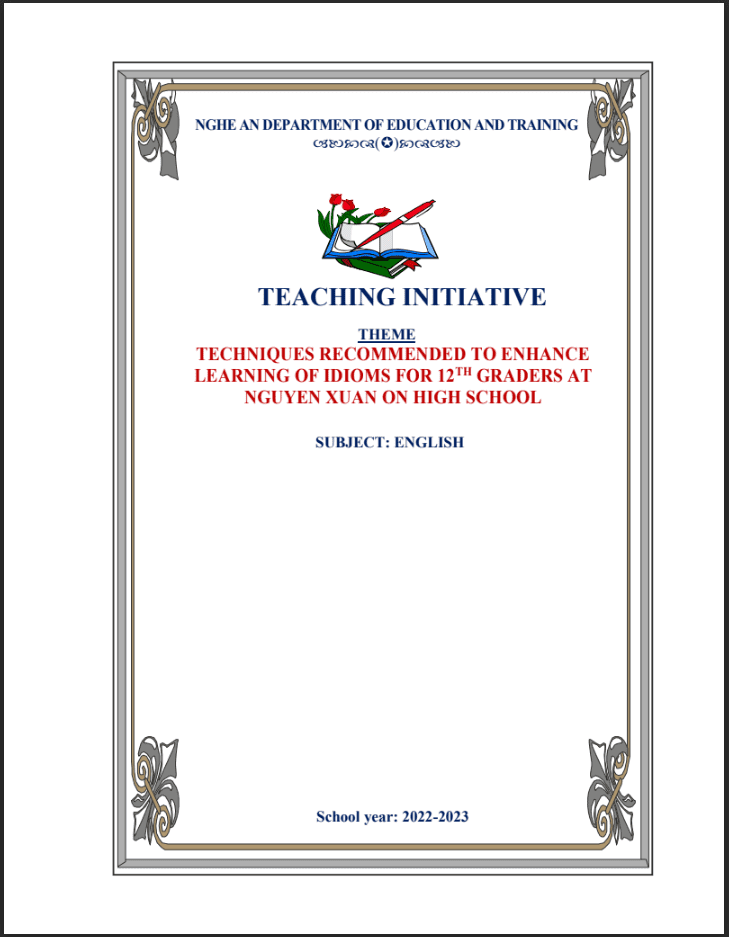SKKN Exploiting cultural factors in teaching communication and culture/ CLIL to enhance students’ participation for grade 10th
- Mã tài liệu: MP0091 Copy
| Môn: | Tiếng Anh |
| Lớp: | 10 |
| Bộ sách: | Global Success |
| Lượt xem: | 504 |
| Lượt tải: | 3 |
| Số trang: | |
| Tác giả: | Đặng Thị Thanh Hiền |
| Trình độ chuyên môn: | Thạc sĩ giáo dục |
| Đơn vị công tác: | THPT Thái Hòa |
| Năm viết: | 2022-2023 |
| Số trang: | |
| Tác giả: | Đặng Thị Thanh Hiền |
| Trình độ chuyên môn: | Thạc sĩ giáo dục |
| Đơn vị công tác: | THPT Thái Hòa |
| Năm viết: | 2022-2023 |
Sáng kiến kinh nghiệm “Exploiting cultural factors in teaching communication and culture/ CLIL to enhance students’ participation for grade 10th”triển khai gồm các biện pháp nổi bật sau:
Mô tả sản phẩm
| PART I. INTRODUCTION |
| 1 |
| .1. Reason for teaching experience |
| As society is increasingly developing, the demand for learning foreign
languages is going up dramatically. The fact that the Ministry of Education and Training stipulates that English is a compulsory subject from grade 3 to grade 12 in the new general education program (issued together with Circular No. 32/2018 / TT- BGĐT dated December 26, 2018 of the Minister of Education and Training) is the clearest evidence affirming that English is an indispensable medium in the context of globalization and international integration in many fields. In recent years, teaching and learning English in high schools has been much more focused when English is a mandatory subject in national high school exams for the majority of candidates and the percentage of candidates applying for university admission related to English is increasing. Therefore, improving the effectiveness of teaching and learning is an urgent need not only for learners but also for those who are directly teaching English. Thus, many Vietnamese, especially the young people, can speak English; however; not many of them have intelligible cultural knowledge. In addition, based on the general dispatch on the development of competency qualities of the overall General education program in 2018, the General education program forms and develops for students the following key qualities: patriotism, kindness, diligence, honesty, and responsibility. Learning culture is an essential component of language learning. Culture provides the context in which language is used, and understanding cultural nuances and practices is crucial for effective communication in any language. Equally important, if culture is integrated with the study of languages, learners can derive long-term benefits from their language learning experience. Therefore, learning culture can give impetus to language learning. Moreover, learners who acquire certain cultural knowledge can grasp information more fully and develop a more positive attitude toward other cultures. They not only gain knowledge of other cultures but also increase their understanding of their own cultures. Therefore, culture needs to be applied to the teaching of language and skills so that learners can know how to speak and write in culturally appropriate ways. Besides, Vietnam has a long-standing traditional culture with outstanding customs and practices and characteristics of a country in the East. Many Vietnamese conceptions of life, people, love, happiness, and dress are sometimes a bit traditional and not as liberal and open as people in many Western countries. That’s why culture shock seems to be a common manifestation when moving to a new country. Furthermore, communication and culture/ CLIL is learnt and taught in a non-native environment, students have little opportunity to discover how these speakers think, feel, and interact with others. That is the reason why they do not feel confident enough to converse with English teachers or native speakers and people in other countries where English is used mainly. Therefore, integrating |
| 2 |
| cultural elements in to language teaching can have many benefits for students,
including increased motivation and engagement, improved communication skills, and a deeper understanding of different cultures. Additionally, CLIL (Content and Language Integrated Learning) is an effective approach to language teaching that combines language learning with subject-specific content, and it has been shown to improve students’ language proficiency and academic performance. By focusing on the cultural aspects of language learning and utilizing CLIL, you can help your students become more competent and confident communicators in both their first language and the target language. |
| For that reason, to make cultural lessons more effective, I have integrated |
| “ |
| Exploiting cultural factors in teaching communication and culture/ CLIL to |
| enhance students’ participation“, Hopefully, I will receive a lot of positive
feedback as well as spread to my colleagues with a view to helping improve the overall goal of education in all parts of the country. |
| 1 |
| .2. Purposes of teaching experience |
| The objectives of the study “Exploiting cultural factors in teaching
communication and culture/ CLIL to enhance students’ participation” may include the following: |
| · |
| To explore the relationship between cultural factors and student
participation in CLIL (Content and Language Integrated Learning) classes. To identify cultural factors that may have effect on student participation in CLIL classes, such as attitudes, values, beliefs, and communication styles. To investigate effective teaching strategies used to address cultural factors and enhance student participation in CLIL classes. To examine the role of cultural awareness and sensitivity in promoting student engagement and motivation in CLIL classes. To assess the effectiveness of cultural-based teaching approaches in enhancing student learning outcomes in CLIL classes. To provide recommendations for teachers and educators on how to integrate |
| · |
| · |
| · |
| · |
| · |
| cultural factors into their teaching practices to foster a more inclusive and
culturally responsive learning environment in CLIL classes. |
| 1 |
| .3. Background of teaching experience |
| The background of the study “Exploiting cultural factors in teaching |
| communication and culture/ CLIL to enhance students’ participation” is limited to |
| 1 |
| 0th-grade students of Thai Hoa High School. Besides, I have used English 10, |
| Global Success, and educational publisher. |
| The study will investigate how cultural factors have great impact on students’
participation in CLIL classes, as well as identify effective teaching strategies that can be used to address these factors and enhance students’ engagement and motivation. The study may involve surveys, interviews, and classroom observations of 10th-grade students in Thai Hoa High School. |
| 3 |
| While the findings of the study may be limited to Thai Hoa High School’s
0th-grade students, they could still have implications for other similar schools that |
| 1 |
| use CLIL teaching methods. The study may provide insights and recommendations
for teachers and educators with the intention of improving their teaching practices as well as promoting a more inclusive and culturally responsive learning environment in their classrooms. |
| 1 |
| .4. Innovation of teaching experience |
| No one can deny that cultural gaps are one of the most important keys leading
us to success in communicating genuinely and understanding the real world outside the classroom. In order to use the language effectively, language teachers should realize that knowledge of the world’s language and culture is increasingly important. Language learners need to have mastery of not only the language itself but also the culture in which the language is used. Therefore, it is suggested that language teachers should focus on the integration of culture in the language classroom, which serves as a tool for helping students understand and appreciate other cultures. Besides that, exploiting cultural factors in teaching CLIL lessons is actually a new way to improve students’ communicative competence, teachers should insert cross-cultural knowledge into the learning and teaching CLIL lessons. Through a variety of new and motivating activities such as movie making, photos, games, talkshows….. Students are provided with a number of opportunities to have a deeper understanding of culture and tradition of some English-speaking countries around textbook topics. In addition, more language knowledge and skills as well as communication skills will be fostered in the best way. |
| Scientifically, it is a useful document for colleagues to apply for the process
of teaching English with a view to motivating as well boosting students to reach their potential. |
| 1 |
| .5. Structure of the research |
| The research paper consists of 3 main parts: The introduction part states the
reasons, context, and scope of the topic. In the content of the study, the author outlines the elements of practical reasoning and methods of solving the problem, the effectiveness of the problem. In the conclusion, the author gives an overview of the topic conclusions and some suggestions for developing research. |
| 1 |
| .6. Plan of the research |
| Number |
| Time |
| Content |
| August |
| Writing outline |
| 1
2 |
| From September 2022 to March 2023 |
| Applying the initiative
and writing research |
| 4 |
| PART II. CONTENT OF THE STUDY
Chapter 1. Theoretical and Practical Background |
| 1 |
| .1. Theoretical basis |
| 1 |
| .1.1. Definition of culture |
| According to UNESCO: ‘Culture is the vivid totality of activities and |
| creations in the past and in the present. Over the centuries, this creative activity has
shaped a system of values, traditions and tastes that define the unique characteristics of each people”1. This definition emphasizes the creative activity of human communities associated with the historical development of each community over a long period of time. so the values have universal humanity, at the same time have the specificity of each community, the unique identity of each nation. However, if we only rely on this general definition, in the state management of culture, we are easily misunderstood: Cultural management is the management of creative activities and, moreover, the management of literary and artistic creations. In fact, cultural management is not like that, cultural management at the commune level is not the only one. Culture is viewed and defined differently from the perspective of researchers. “Culture is a centralized belief, attitude, custom. The behavior and social habits of a community” [1]. Culture therefore plays an important role in the community. So culture is the glue that holds communities together. Culture as defined by Lado [2] is synonymous with the way people live and work in certain areas. Content and Language Integrated Learning (CLIL) as defined by Joanna Wiseman [3] is an approach where students learn a subject and a second language at the same time. A science course, for example, can be taught to students in English and they will not only learn about science, but they will also gain relevant vocabulary and language skills. It’s important to note that CLIL is not a means of simplifying content or re- teaching something students already know in a new language. CLIL courses should truly integrate the language and content in order to be successful – and success is determined when both the subject matter and language is learned. |
TÀI LIỆU LIÊN QUAN
- 7
- 105
- 1
- [product_views]
- 5
- 173
- 2
- [product_views]
- 4
- 165
- 3
- [product_views]
- 4
- 129
- 4
- [product_views]
100.000 ₫
- 6
- 434
- 5
- [product_views]
100.000 ₫
- 2
- 507
- 6
- [product_views]
100.000 ₫
- 9
- 546
- 7
- [product_views]
100.000 ₫
- 4
- 409
- 8
- [product_views]
100.000 ₫
- 2
- 595
- 9
- [product_views]
100.000 ₫
- 0
- 538
- 10
- [product_views]

